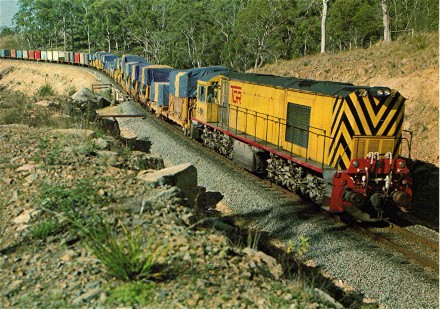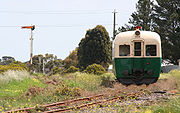
Tasmanian Government Railways
Encyclopedia

Government of Tasmania
The form of the Government of Tasmania is prescribed in its Constitution, which dates from 1856, although it has been amended many times since then...
managed operator of mainline railways in Tasmania
Rail transport in Tasmania
Rail transport in Tasmania consists of a network of narrow gauge track of reaching virtually all cities and major towns in the island state of Tasmania, Australia. Today, rail services are focussed primarily on bulk freight, with no commercial passenger services being operated...
, Australia
Australia
Australia , officially the Commonwealth of Australia, is a country in the Southern Hemisphere comprising the mainland of the Australian continent, the island of Tasmania, and numerous smaller islands in the Indian and Pacific Oceans. It is the world's sixth-largest country by total area...
. It was formed in 1888 and existed until absorbed into the Australian National Railways Commission
Australian National Railways Commission
The Australian National Railways Commission was a government owned railway operator in Australia. ANRC was also known as Australian National Railways in its early years and was later rebranded as Australian National .-History:...
in 1978.
History
The Tasmanian Government Railways was established under a General Manager for Railways in 1888, to take over failed private railways, the first privately operated railway having started construction in 1868. In 1978 the Tasmanian government took up an offer by the WhitlamGough Whitlam
Edward Gough Whitlam, AC, QC , known as Gough Whitlam , served as the 21st Prime Minister of Australia. Whitlam led the Australian Labor Party to power at the 1972 election and retained government at the 1974 election, before being dismissed by Governor-General Sir John Kerr at the climax of the...
Federal Government to take over the state owned railways, which resulted in the TGR being absorbed into the new Australian National Railways Commission
Australian National Railways Commission
The Australian National Railways Commission was a government owned railway operator in Australia. ANRC was also known as Australian National Railways in its early years and was later rebranded as Australian National .-History:...
, operating as TasRail.
Rolling Stock

The passenger rolling stock of the TGR included the 1955-58 series ACS class 'articulated country saloons', 76-seat first class with air suspended reclining seats, tray tables, state-of-the-art lighting and heating, and buffet service with hostesses. To the end in 1978, the TGR still used AAL class first class saloons with leather seats and maple panelling, as well as SP class brake and 2nd class passenger carriages, converted from Sentinel steam railcars.
The beautiful DP class articulated inter-urban and country service railcars as well as the big western line DP cars and smaller suburban railcars were heavily used to the end, and many are in preservation today.
Pacific Locomotives
Tasmanian Government RailwaysTasmanian Government Railways
The Tasmanian Government Railways was the former Government of Tasmania managed operator of mainline railways in Tasmania, Australia...
owned 14 [4-6-2] Pacific type locomotives. The class was introduced in Tasmania when Australian locomotive building company Perry Engineering Co, Adelaide
Adelaide
Adelaide is the capital city of South Australia and the fifth-largest city in Australia. Adelaide has an estimated population of more than 1.2 million...
, Australia built four Pacific type locomotives class R1 - R4 to Tasmanian Government Railways. They were used mainly in passenger trains.
The next batch of Pacific type locomotives arrived to Tasmania in 1952. The British locomotive builder Robert Stephenson and Hawthorns
Robert Stephenson and Hawthorns
Robert Stephenson and Hawthorns Ltd was a locomotive builder with works in North East England.-History:The company was formed in September 1937 when Robert Stephenson and Company, which was based in Darlington took over the locomotive building department of Hawthorn Leslie and Company, based in...
delivered ten locomotives in 1951 for Tasmanian Government Railways. These locomotives class M 1 - M10 were used in all trains on major lines in northern Tasmania
Tasmania
Tasmania is an Australian island and state. It is south of the continent, separated by Bass Strait. The state includes the island of Tasmania—the 26th largest island in the world—and the surrounding islands. The state has a population of 507,626 , of whom almost half reside in the greater Hobart...
. In 1957–1958 four locomotives (then in worst mechanical condition) had their driving wheels replaced by then surplus 1220 mm Garratt wheel sets. These four locomotives were reclassified class MA1 - MA4.
The use of steam locomotives declined in 1960s, but Pacific type locomotives were still used on Hobart
Hobart
Hobart is the state capital and most populous city of the Australian island state of Tasmania. Founded in 1804 as a penal colony,Hobart is Australia's second oldest capital city after Sydney. In 2009, the city had a greater area population of approximately 212,019. A resident of Hobart is known as...
suburban trains. Occasionally they hauled special tour trains. In 1964 three locomotives; M1, M2, and MA3 were stored (in serviceable condition).
In 1971, when Tasmanian Government Railways had its Centenary celebrations, six of ten locomotives were still in serviceable condition. These being; M3, M4, M5, M6, MA2 and MA4.
The end came few months later when all were simultaneously withdrawn from service. M3 was later restored to working order and it was hauling several years some suburban trains at Hobart area, being finally written off from service in October 1975. These 96.6 ton (in working order) engines were much liked among the locomotive drivers.
List of TGR Pacific type locomotives: (locomotives shown by UIC
International Union of Railways
The UIC , or International Union of Railways, is an international rail transport industry body.- Brief history :The railways of Europe originated as separate concerns. There were many border changes after World War I and the Treaty of Versailles. Colonial railways were the responsibility of the...
standard).
h = superheated. 2 = number of cylinders.
- R1 2C1-h2 Perry - / 1923
- R2 2C1-h2 Perry - / 1923
- R3 2C1-h2 Perry - / 1923
- R4 2C1-h2 Perry - / 1923
- M1 2C1-h2 RS&H 7421 / 1951 rebuilt 1957 to MA2
- M2 2C1-h2 RS&H 7422 / 1951 rebuilt 1958 to MA4
- M3 2C1-h2 RS&H 7423 / 1951
- M4 2C1-h2 RS&H 7424 / 1951
- M5 2C1-h2 RS&H 7425 / 1951
- M6 2C1-h2 RS&H 7426 / 1951 rebuilt 1957 to MA1
- M7 2C1-h2 RS&H 7427 / 1951 renumbered to M1
- M8 2C1-h2 RS&H 7428 / 1951 rebuilt 1958 to MA2
- M9 2C1-h2 RS&H 7429 / 1951 renumbered to M6
- M10 2C1-h2 RS&H 7430 / 1951 renumbered to M2
Preservation:
- M1 Dervent Valley Railway, New Norfolk
- M2 Tanfield Steam Railway, Gateshead upon Tyne, England
- M3 Don River Railway, Devonport
- M4 Don River Railway, Devonport
- M5 Tasmanian Transport Museum, Glenorchy, Tasmania
- M6 Bellarine Peninsula Railway, New Norfolk
- MA1 Dervent Valley Railway, New Norfolk
- MA2 Don River Railway, Devonport
- MA3 Public Park, Margate
- MA4 Don River Railway, Devonport
Operations
In the early 1970s Hobart railway station saw more than 70 trains a day coming and going. Today that number is 2 or 3, all reduced to a single track with 10–15 km minimum distance between trains.The demise of the TGR in 1978 also saw the cessation of passenger operations; the last service ran on 28 July.

